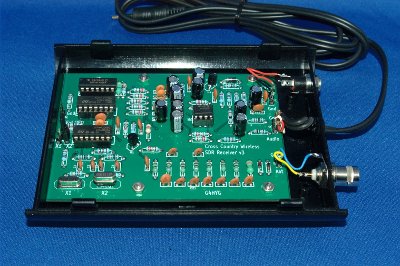
Cross Country Wireless Experimenters Special SDR Receiver

Cross Country Wireless Experimenters Special SDR Receiver
Product discontinued, web page for information only
The Cross Country Wireless Experimenters Special SDR Receiver is a compact high performance HF software defined radio receiver designed to be used in fixed or portable stations.

Version 3 of the receiver is now available. It now has an RF pre-amplifier using a power MOSFET and other revisions to improve it's performance both as a stand alone receiver and as an IF panadaptor with HF and VHF transceivers. Following the development of our new SDR-4+ general coverage receiver we have also re-designed the audio amplifier to minimise changes in audio phase. This ensures that once the I/Q amplitude and phase balance is set it remains constant over the bandwidth of the receiver so that the unwanted sideband rejection remains high.
It has a choice of two internal crystal oscillators or an external VFO input, it's got good RF filtering (high and low pass filters similar to our VHF/UHF filters) before the RF pre-amplifier and it's optimised for use with any stereo input sound card so you won't need to buy an expensive sound card to start to use it. It can also be used with high performance sound cards for a wider tuning range and greater dynamic range.
The SDR receiver is now available in two versions. The Experimenter's Special version can cover 6 to 15 MHz depending on crystals. It has a crystal centre frequency of 7.156 MHz in the X1 crystal position and a HC25/u crystal socket in the X2 position. A selection of crystals are supplied with the receiver covering centre frequencies of 7.056, 9.000 (for some Yaesu, Kenwood and Icom IF frequencies), 10.125 and 14.250 MHz.
The 455 kHz version has an offset centre frequency of 460.5 kHz so that it can be used as a SDR panadaptor on existing receivers or transceivers fitted with a 455 kHz IF output.
Using a 48 kHz sound card, SDR software can tune +/- 24 kHz from the centre frequency. With a 96 kHz sound card, SDR software can tune +/- 48 kHz from the centre frequency.
It also has a second crystal so that it can cover the 600m amateur band. This has a centre frequency of 500 kHz so a 48 kHz sound card will cover 476 to 512 kHz.
Features include:
High performance software defined receiver
Multiband Experimenter's Special or 455 kHz versions
Two crystal oscillators and an external VFO input
RF band pass filter and RF amplifier using a power MOSFET in receiver front end
Works well with 48 kHz or 96 kHz stereo input sound cards
Minimum signal detectable is better than -135 dBm with a 48 kHz 16 bit sound card
LO output to the antenna is less than -70 dBm
Compatible with SDR software designed for Softrock receivers such as HDSDR, Rocky 3.7, PowerSDR, Winrad, CW Skimmer, SDR Sharp or SDR-Radio
No surface mount components
Supplied built, aligned and tested with a detailed specification sheet
Supplied with a CD-ROM containing sample SDR and digital mode programs
Power requirements 7 to 25V current consumption 73 mA
Complies with FCC Part 15 rules and CE specifications for EMC, RoHS and WEEE
Built to last with high grade components in a tough ABS case
Supplied with connection details, circuit, instruction manual and sample software on a CD
Special frequency requirement? IF pan-adaptor? Beacon receiver?
Just insert a suitable HC-25u crystal in the X2 crystal socket in the Experimenter's Special SDR receiver. The calculation for the crystal frequency is the wanted centre frequency x 1.3333. So for example if you wanted to use the Experimenter's Special SDR receiver as an IF pan-adaptor for a Elecraft K3 transceiver with an IF frequency of 8.215 MHz you would need a crystal with a frequency of 8.215 x 1.3333 = 10.953 MHz. Easy!
You can download the SDR Receiver Operating Manual here.
You can download the Experimenters Special SDR Receiver crystal information sheet here.
You can download the Experimenters Special SDR Receiver flyer here.
You can also download a sample WAV file here. The sample file is a 5 minute recording of 96 kHz of the 40m amateur band during the Worked All Europe RTTY contest on 14 November 2010. It was recorded at Bolton, England using the SDR-Radio SDR program using a 40/30m SDR Receiver with a 1/4 wave vertical antenna. The 4.8 MB ZIP file extracts to a folder containing a 100 MB WAV file.
Contact Chris Moulding, G4HYG via info@
|